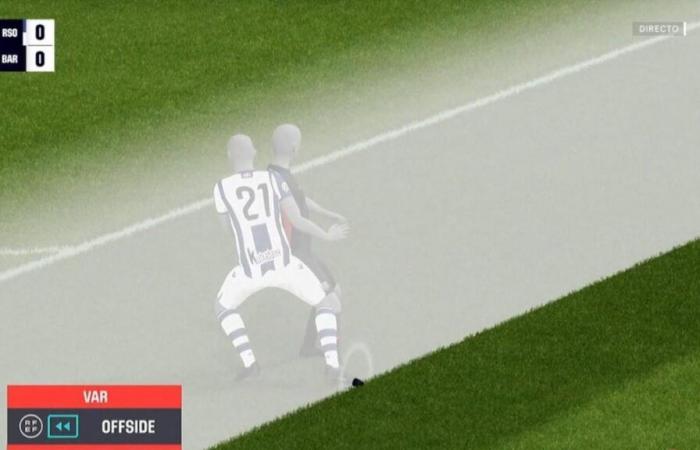SAOT, the acronym in English for Semi-Automated Offside Tech, is the new fashionable concept in Football, released this season in the League. It is the latest application of technology to end the offside controversy (or generate even more); something like the truth revealed, through images and computing, without the human factor intervening. A supposedly infallible method that should not raise any further doubts. But it is not like that.
3D technology
What is semi-automatic offside?
What is semi-automatic offside? This is a technology that allows you to distinguish whether a footballer is in an illegal position instantly in cases of offside. The technology, called limb-tracking (extremity detector), uses 3D recreation to determine the position of the players. It began to be tested by FIFA in 2021 in the Africa Cup and the Club World Cup, and it also did so in the 2022 World Cup in Qatar. It was definitively implemented from the 2023-24 Champions League.
A single licensed company
Who manages it?
This technological system, developed by the Skeletrack brand of the company Hawk Eye Innovations (the only one licensed by UEFA and FIFA), belonging to Sony, has been used in sports since 2018, with a background of more than 32,000 games of soccer, baseball, basketball, American football and ice hockey.
Being the only supplier accredited by FIFA, it was the company to which the Spanish Football Federation (RFEF) awarded the contract in January for four seasons, from the current one to 2027-28, applicable in official First Division matches ( in the Second, from the 2025-26 academic year). The cost of the system is 5 million euros.
The 29 points of the human skeleton monitored by the SAOT system
RFEF
Cameras and body monitoring
How does it work?
How does the offside detection system work? To determine the exact position of a footballer on the field of play, the Skeletrack system captures 29 monitored points on each player’s body – “One of the most important is the tip of the foot,” according to Iturralde González -, which allows creating in real-time visual representations in three dimensions. Capturing the points is possible thanks to between 10 and 12 cameras installed on the roofs of the stadiums – which operate independently of the television broadcast – and which provide up to 50 shots per second of each footballer.
In addition, the system takes the ball into account, which sends 500 signals per second and allows the exact moment in which the boot contacts the ball in the last pass to be identified. This information is possible thanks to an inertial measurement unit (IMU) sensor installed inside the ball.
From the moment the play occurs until the detection
How long does it take?
Thanks to this technology, the referees in the VOR room can know whether or not there is an offside in a very short time, an average of 25 seconds from when the play with the alleged infraction occurs. The work that the system gives them is minimal: VAR referees only have to determine the exact frame, which coincides with the first contact with the ball when the pass is executed. The system automatically draws the lines of the attacker and defender, and recreates the image in 3D to display to spectators.
Human intervention
Why is it “semi-automatic”?
The system is called “semi-automatic” because it requires a final check by the referees in the VOR room before informing the referee on the pitch. In case of doubt, the VAR referee can adjust the exact moment of hitting the ball or the offside line generated by the technology.
Speed and automation
The SAOT versus the VAR
The main advantage of the semi-automatic offside system is its speed and automation, which reduces the human factor. The review of an offside using VAR (video refereeing) can take more than a minute (70 seconds, FIFA estimates), while SAOT reduces the time to about 25 seconds. In addition, semi-automatic offside minimizes the risk of human error by providing accurate data collected precisely with monitored points on the body and ball, while in VAR, the video referee team selects the hitting point of the ball. ball and draw the offside line manually. In SAOT, the VOR room referee only needs to validate the proposed decision by checking the automatically created offside line.






